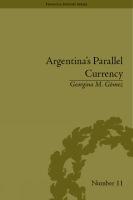Argentina’s Parallel Currency The Economy of the Poor
Georgina M. Gómez, Pickering and Chatto Publishers, London, UK, 2009

The story of the Red de Trueque in Argentina (RT) exposes the problems of creating a grassroots market system parallel and complementary to the official economy. The RT was launched in 1995 by a group of environmentalists who exchanged goods and services at their own ‘market’ using a system of mutual credit. The group grew and they printed fiat money to facilitate exchange. The scheme was rapidly replicated across Argentina as the country’s official economy faced meltdown. At its peak, the RT had 2.5 million participants and 4,700 marketplaces. However, although the organisers set codes of conduct and bodies to enforce them, it was impossible to deal with such a large self-regulated market and it collapsed to about a tenth of its peak size in a matter of months.
This is the first book in English to analyse the rise and fall of RT. Gomez advances institutional theory by exploring how structural reforms disrupt institutions, here resulting in segments of unstable and uncertain economic action within the social structure. She identifies rules of governance and sustainability for institutional settings in which compliance is voluntary and state regulation is minimal. Finally, Gomez conceptualizes the economy of the poor and disenfranchised as an economic area driven by the need to survive, thus structured by specific institutions different to those guiding the economic action of the non-poor.
